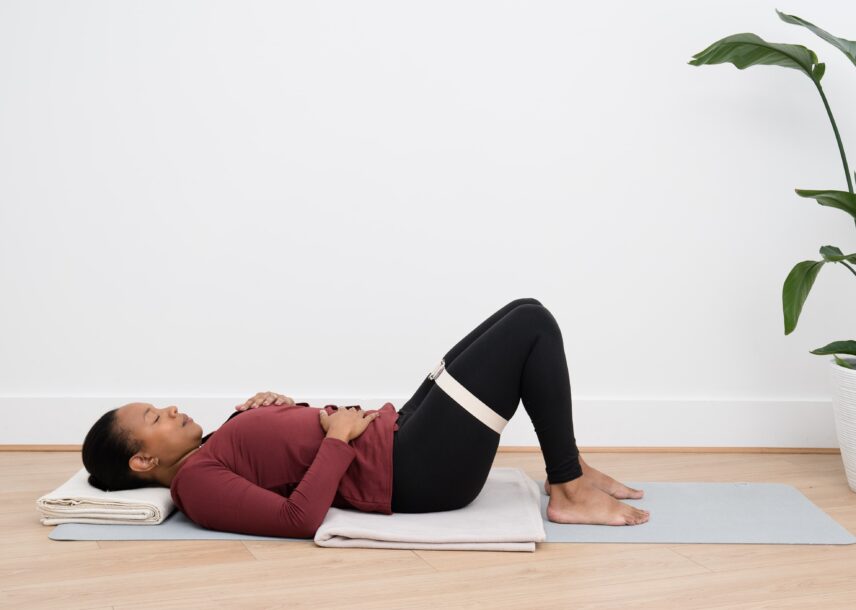I am sure it will come as no surprise if I say that Low Back Pain (LBP) is one of the most common complaints in the adult population and the most frequent reason to see a GP.
However, what might come as a surprise is that research shows that an appropriate yoga practice can both prevent and improve LBP.
The spinal cord acts as a conduit of information between the brain and the body; it’s in control. If we feel pain we so often tighten and restrict, we do what we think is needed to protect. We don’t think of space, of lengthening, of breathing deeply and fully. Our breath can become laboured, short and sharp. And thus continues that cycle of pain.
With these 5 asanas my intention is to help you find space through understanding how to move with strength and mobility. You can combine them as a mini practice, or work on them individually to really delve into the nuances of an asana, especially in relation to your spine: how it feels; where you’re holding tension; where you can find space; and a deep, free flowing breath.
ERP moving into Windscreen Wipers with Diaphragmatic Breathing
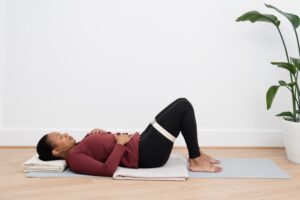
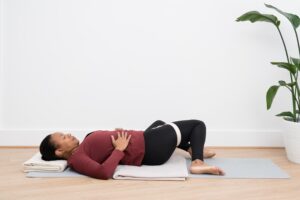
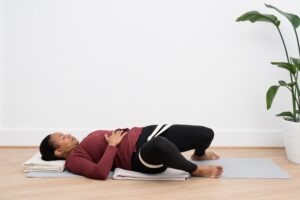
Fold your first blanket enough to support your head and neck, bringing the soft folded edge in towards the shoulders so that you find comfort.
Fold the second blanket so that it’s just wider than the width of your mat and place it under the lower part of your back, in line with your bellybutton region. These two blankets are to support the natural curve of your lumbar spine and your neck spine.
Loop the belt around your mid-thigh so that your legs hit out to hip width apart. Bring one hand to your chest and the other to your belly and close your eyes. Start to feel the current of your breath, no judgements, just notice. How do you feel? If your inhale feels laboured, start to use your exhale to help you find ease and softness. Scan your body from the grounding of your feet up to your knees, down to your pelvis, along the natural curves of your spine up to the crown of your head.
Take a few cycles of breath.
Now, picture your diaphragm, the main muscle when it comes to respiration. The diaphragm sits below the lungs, attaches to the sternum (where your top hand is), the base of the rib cage and the front of the lower (lumbar) spine (where the bottom hand is). So, with your hands placed where they are, picture your lungs as you inhale, your diaphragm contracts and pulls downward. And then, when your lungs exhale, the diaphragm domes up like a jellyfish, and the thoracic cavity (chest area) decreases.
Notice any patterns of holding and give yourself time in this conscious diaphragmatic breathing. Surrender to a deeper breath.
Transition into windscreen wipers, move your hands so that the middle fingers just about graze, elbows on the floor, shoulders away from your ears. Keeping the belt looped as is or slightly loosening – inhale here and then exhale take your knees down to the right. Synchronising your breath with your movement – repeat with 5 each side. Notice the natural ebb and flow of your breath.
Toe Taps – How can we work with Sthira and Sukha?

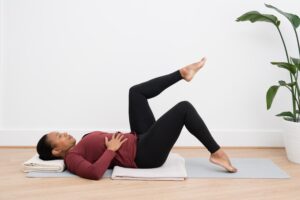
I often find there’s a disconnect when trying to match a quote to a sequence or an asana. But there’s a wonderful quote by the late Geeta Iyengar, “A practitioner of yoga needs both qualities mobility and stability, the inspiration to proceed & the adhesiveness to establish oneself.” With Geeta’s words in mind, bring your hands to your lower belly and start to engage your core body – controlled but not gripped. Lift both feet off the floor at the same time, bring them in line with your hips. One at a time lower one leg, whilst still bent, and gently tap your toes onto the floor and – with that stability and mobility – bring your leg back in line. Repeat with 5 each side.
Modification: If having both of your legs lifted is too strong, allow one leg to remain bent with the foot on the floor.
Bitilasana / Marjaryasana (Cat / Cow)
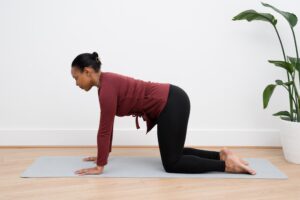
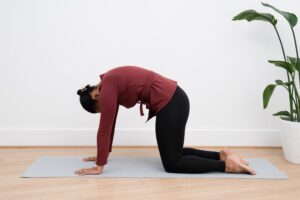
For asanas that feel like second nature we can often just go into them without an intention. So, for cat/cow I want you to think of your breath as the navigator for space, mobility and length.
Set-up on all-fours, knees under hips, wrists under shoulders, toes untucked or tucked – go with what feels more stabilising. Begin with a neutral spine, lengthen through the tailbone, head in line with your neck, gaze down or close your eyes.
With an inhale push through your hands and draw your head in, chin towards chest and at the same time draw your tailbone in so that you’re stretching the spine up towards the ceiling. With your exhale start to lengthen back to a neutral spine, stay here and lift your pelvic diaphragm for more strength. For control and protection of your lumbar spine, we stay in this neutral position. Repeat for a few minutes.
You may be used to exhaling as you curl up, but accessing a deeper, fuller breath is encouraged when breathing into your back body – a cue you might have heard in classes. This is because our lungs come down to our 10th rib at the back and the 6th at the front.
Superman
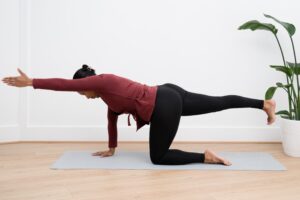
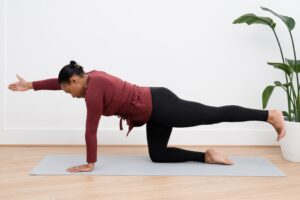
Our balance is so important in helping us to build strength, and in many ways live a longer, better life. Very melodramatic, but you may recall an article from last year (2022) which linked health in later life and the positive impacts when there was an ability to balance on one leg.
So, start on all-fours and employ that same engagement accessed during the toe taps and bring stability to your core body. Lengthen through your right leg, tuck your toes and reach through your heel. Breathe. Bring your leg in and repeat on your left side.
Progression 1: Once you’re comfortable and feel you’ve got your balance, lift your outstretched leg, maintaining length in your lower back.
Progression 2: To test your balance even further, when you stretch and lift your right leg, lift your left arm, reach and lengthen. Repeat on the other side.
Adho Mukha Svanasana (Downward Facing Dog) with bent legs
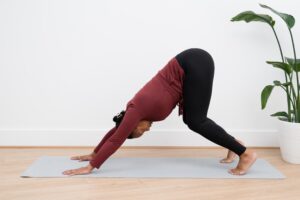
From all fours take your hands just forward of your shoulders, knees slightly back from your hips. Push through your hands as you start to lift your tailbone towards the ceiling, deeply bend your legs to encourage space along your spine. Outer hips draw in for stability. Reach through your arms for even more lift, but keep your ribs drawing together so as not to flare. Come down and rest in balasana (child’s pose) after a few cycles of breath.
These asanas are suitable for people with general aches and pains in all areas of the spine and particularly for those who have lower back concerns. Though, please be aware that Yoga for BackCare is not suitable if you are currently suffering a new or acute episode of undiagnosed back pain. Listen to your body when it’s trying to tell you something. Give yourself permission to take control.


